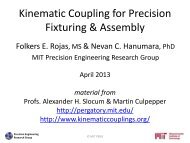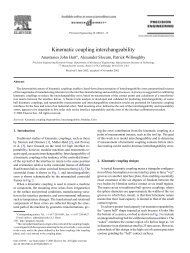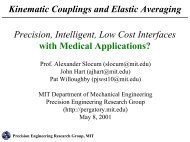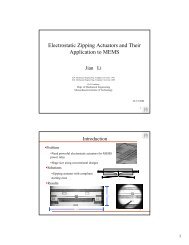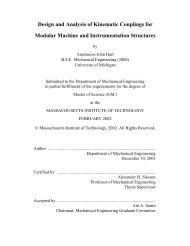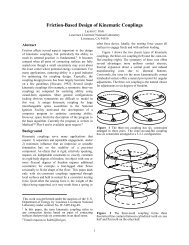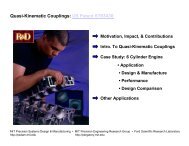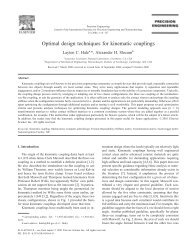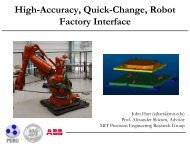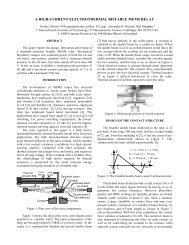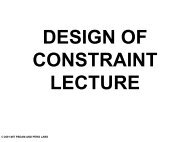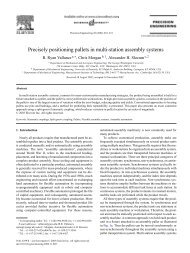Design of a Hybrid Positioner-Fixture for Six-axis Nanopositioning ...
Design of a Hybrid Positioner-Fixture for Six-axis Nanopositioning ...
Design of a Hybrid Positioner-Fixture for Six-axis Nanopositioning ...
You also want an ePaper? Increase the reach of your titles
YUMPU automatically turns print PDFs into web optimized ePapers that Google loves.
<strong>Design</strong> <strong>of</strong> a <strong>Hybrid</strong> <strong>Positioner</strong>-<strong>Fixture</strong> <strong>for</strong> <strong>Six</strong>-<strong>axis</strong> <strong>Nanopositioning</strong> and Precision FixturingSubmitted to Precision Engineering(2) Random errors: Due to the drift min the piezos, the data should be considered in terms <strong>of</strong> short-term(point-to-point, PP) per<strong>for</strong>mance rather than the long-term (absolute, ABS) per<strong>for</strong>mance. Table 5provides the one sigma repeatability in each <strong>of</strong> the six axes <strong>for</strong> PP and ABS.Table 5: <strong>Fixture</strong> repeatability data (values correspond to 1 standard deviation)X[nm]Y[nm]Z[nm]x[radians]y[radians]z[radians]Mates ABS PP ABS PP ABS PP ABS PP ABS PP ABS PP0 - 100 36 14 53 12 68 39 0.60 0.28 0.60 0.28 2.00 0.43700-1000 30 9 34 9 163 35 0.60 0.61 0.60 0.28 2.00 0.270 - 1000 58 11 87 11 288 38 1.4 0.65 1.00 0.29 2.30 0.32The PP values indicate the fixture can be repeatable on the level <strong>of</strong> tens <strong>of</strong> nanometers and fractions <strong>of</strong>micro-radians if actuation inputs remain steady. This level <strong>of</strong> per<strong>for</strong>mance from a passive fixture isthought to be due to elimination <strong>of</strong> ball-groove stick slip. Stick slip prevents the balls from settling intotheir lowest energy state and there<strong>for</strong>e limits the repeatability <strong>of</strong> kinematic couplings [11]. As the ballssettle into the grooves, the balls and grooves slide in the directions indicated by the exaggerated wearpatterns in Fig. 8. The groove flexures prevent the random stick slip phenomena at the ball-groovecontacts, thereby enabling the HPF to settle into a state which is closer to its minimum energy state.Although lubricants can be used to reduce this effect [12] when flexure bearings are not used, such anapproach is limited to non-vacuum applications. We hypothesize that the flexures may also reduce thedependence <strong>of</strong> repeatability on the order <strong>of</strong> engagement <strong>of</strong> the balls and grooves. Both issues are subjects<strong>of</strong> continued work via experiments on kinematic couplings which are not equipped with actuators, butwhich are equipped with the same groove flexures.6.6. Stiffness characteristicsThe fixture was preloaded to provide approximately 7 N/micron stiffness in the x, y and z directions. TheX and Y stiffness were obtained by hanging weights on the distal end <strong>of</strong> a string and attaching theproximal end to the fixture. The string was routed such that the tension in the string was directed parallelto the plane <strong>of</strong> coupling and through the coupling centroid. A comparison <strong>of</strong> predicted and experimentalresults is provided in Table 6. Experimental results show that the fixture is stiffer than expected byapproximately 30 %. This was expected as the modeling approach assumed conservative values <strong>for</strong> thestiffness <strong>of</strong> individual compliant components. A better match between theory and measurement isdesired; there<strong>for</strong>e future work will be focused upon improving the accuracy <strong>of</strong> the model.Table 6: HPF stiffness – experimental vs. analytical resultsKx[N/µm]Ky[N/µm]Experimental 10.0 10.0 10.1Analytical model 7.1 7.1 7.3% error 29.7 29.2 27.9Kz[N/µm]24



